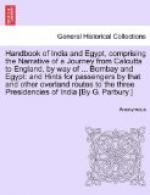The most curious feature of the Mohurrum celebration is the roystering and brawling of the Tolis or street-bands which takes places for two or three nights after the fifth day of the month. Each street has its own band ready to parade the various quarters of the city and fight with the bands of rival streets. If the rivalry is good-humoured, little harm accrues; but if, as is sometimes the case, feelings of real resentment are cherished, heads are apt to be broken and the leaders find themselves consigned to the care of the Police. It is difficult to see the connection between these brawling street-companies and the lamentation for Hasan and Husein; but the rivalry of the mohollas recalls the free-fighting which used once to take place between the various quarters of Gujarat and Kathiawar towns during the Holi festival, while the beating, shouting and general pandemonium evoked by the Tolis are probably akin to the extravagance once practised at the beating of the bounds in England and Scotland and are primarily designed to scare away evil-spirits from the various quarters of the city. The Tolis are indeed a relic of pure Hinduism—of aboriginal spirit-belief, and have in the course of centuries been gradually associated with the great Mahomedan Festival of Tears. Originally they can have had no connection with the Mohurrum and are in essence as much divorced from the lamentation over the slaughter at Karbala as are the mummers, the Nal Sahebs and the Lords of the conchshell (Sain Kowra) of the modern celebration from the true Mahomedan who wanders back from the sea-shore uttering the cry of grief—
“Albida, re albida, Ya Huseini albida.”
“Farewell, farewell, ah, my Husein,
farewell!”
VII.
THE POSSESSION OF AFIZA.
It was quite evident that something was seriously wrong with Abdulla the Dhobi. His features had lost their former placidity and wore an aspect of troubled wonder; the clothes which he erstwhiles washed and returned to their owners with such regularity were now brought back long after the proper date and occasionally were not returned at all; and the easy good temper which once characterized his conversation had yielded place to sudden outbursts of anger or protracted spells of sulkiness. The major-domo consulted on the point could only suggest that Abdulla’s ill-temper was typical of the inherent “badmashi” of the Dhobi nature and that probably Abdulla had taken to nocturnal potations, while the youngest member of the household unhesitatingly laid down that Abdulla had been seized by a “bhut” or in other words was possessed of a devil. When the former suggestion was laid before Abdulla, he contemned it with unmeasured scorn and then turned and rent the spirit of the butler with winged words, but the small boy’s opinion seemed to give him pause. He held his peace for a moment, gazing earthwards and rubbing a small heap of dust towards him with his toe; and then on a sudden he burst out into the tale which is here set down in his own words:—




